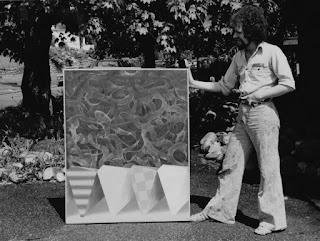ESSAY FOR EXHIBITION AT THE
ADELINDA ALLEGRETTI STUDIO GALLERY
To trace the complex
development of Gregg Simpson's artistic research, it is necessary to look at
not only Canadian but European events in the history of art over the last fifty
years. For the visitor who approaches his works for the first time, it
would be difficult to believe that the roots of his painting date back to the
Pop Art of the 1960s, although identifiable in the chromatic sense of some
works.
But it is precisely
the constant attention to experimentation that led Gregg to confront himself in
the following decade with Neo-Surrealism and, in the 1980s, with abstraction of
an organic nature, from which he never separated. It is from here,
therefore, that our analysis begins.
But before that, I
think it's essential to know where Gregg was born and raised because the
rainforest of the Canadian west coast has indelibly marked his artistic
identity. Perhaps for those who live in a metropolis it is difficult to
fully understand the everyday life spent in symbiosis with nature.
Works like Crystal
Currents (2014), Dream Dancers (2014), Floral Still Life (2016), Horned Dilemma (2017), Landscape
Ritual (2016) and The Group (2014) are the result, on one hand, of constant
immersion in nature and on the other, through a subsequent mental process, its geometrization
and exemplification.
This creative process is not
conceptually so far from that of First Nations art, in which rivers, stones,
flowers and trees, Gregg's favorite subjects, are deconstructed, simplified so
much so that a single detail, formal or chromatic, manages to express their
complexity and the essence. But what is the purpose of all this? That
of freeing the forms, of releasing the vital energy inherent in them, of
grasping, like First Nations artists, the spirituality and harmony of that
land.
Speaking of harmony: his
works are crossed by a rhythm, also free and which does not follow a pentagram
scheme, which the forms seem to subtend, even sometimes apparently massive
ones which yet become so ethereal, almost dancing.
I think this is explained by the fact that Gregg is also a good drummer and musician, so much so that, I am convinced, the best way to enjoy his paintings is to immerse them in his music. In Gregg's artistic work there is no clear distinction between painting and music, on the contrary one implements the other, in a constant search for harmony and primary meaning that allow us to glimpse the profound essence of life deprived of its tinsel beauty.
Also on display is a series
of gouaches and pastels on paper made in 2015 between Murano and
Ravenna. In addition to remembering Gregg's love for Italy, which has
hosted and inspired him many times, I believe they testify, with their
particularly flickering and gestural brushstrokes embroidered in the air,
precisely the undeniable union between music and painting, in this case made
even more complicit by the brilliance of the glass and the reflections of the
water on one side, and by the gold of the mosaics on the other.
I feel I can say that Gregg’s
show is probably not, and does not want to be, an exhibition for everyone, but
it will certainly charm those who do not like to stop at the first glance, and
who instead wish to look a little deeper into the depth of things.
Adelinda Allegretti, Gualdo
Tadino, 2018



































